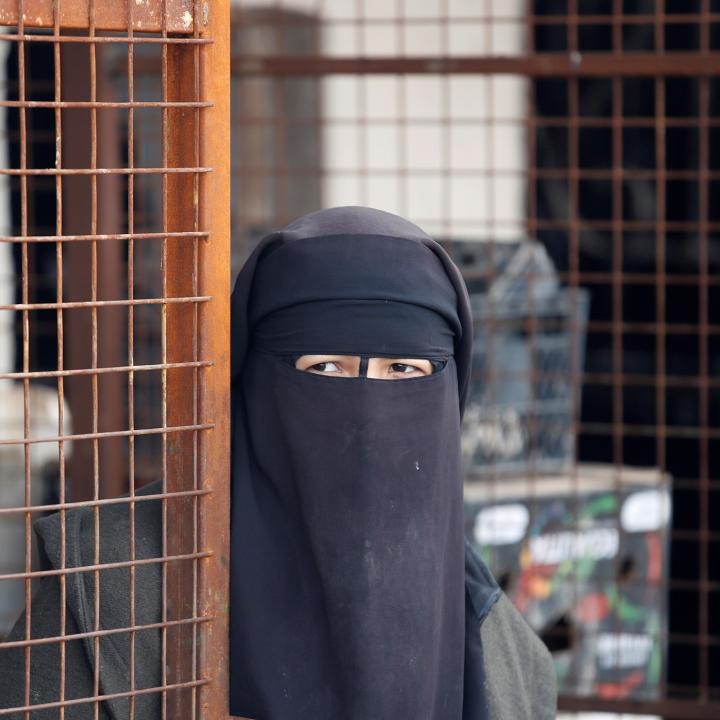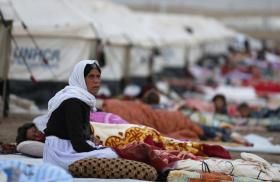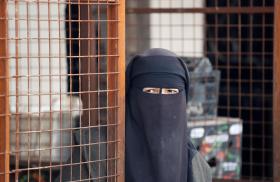
- Policy Analysis
- PolicyWatch 3747
What to Do With Families of Islamic State Foreign Fighters

Part of a series: Counterterrorism Lecture Series
or see Part 1: U.S. Efforts against Terrorism Financing: A View from the Private Sector
Backed by hard data, on-the-ground observations, and best practices, three experts explore the thorny question of repatriating the children and spouses of imprisoned jihadists.
On June 1, The Washington Institute held a virtual Policy Forum with Martyn Warr, Austin Doctor, and Devorah Margolin. Warr leads the Counter-Daesh Communications Cell in Britain’s Foreign, Commonwealth, and Development Office. Doctor is the director of counterterrorism research initiatives at the National Counterterrorism Innovation, Technology, and Education Center (NCITE), an assistant professor of political science at the University of Nebraska at Omaha, and coauthor (with Margolin) of the study “Reintegration of Foreign Terrorist Fighter Families: A Framework of Best Practices for the U.S.” Margolin is the Blumenstein-Rosenbloom Fellow at The Washington Institute and an adjunct professor at Georgetown University. The following is a rapporteur’s summary of their remarks.
Martyn Warr
Currently, many women and children affiliated with the Islamic State (IS) remain in camps run by the Syrian Democratic Forces (SDF) and international military contingents in northeast Syria, and resolving their situation is a priority for the coalition. Although IS has been defeated territorially, it still has a degree of ideological influence and operational capabilities within these camps, using them as a tool for radicalization, recruitment, and support. Children are especially vulnerable to these radicalization efforts, in part because they do not receive adequate education—in many cases, their principal educators are likely IS affiliates.
In addition to security concerns, camp residents face very poor humanitarian circumstances. To address these problems, authorities need to reduce the size of the camps as much and as quickly as possible. This would also help contain the IS threat militarily and psychologically in the long term.
In late 2022, the coalition brought together key political, military, humanitarian, government, and nongovernmental representatives in Amman, Jordan, to discuss repatriation efforts for the first time. Repeating this type of large-scale, targeted meeting is necessary to advancing repatriation. Since that gathering, repatriation efforts from Syria’s al-Hawl camp have achieved some success—this week, the camp’s population is set to fall below 50,000 for the first time since March 2019, when IS lost its last bit of territory in Baghuz. The coalition will continue to focus on this issue at its imminent ministerial meeting in Riyadh, seeking more funds specifically for helping residents inside the camps, repatriating them, and bolstering the communities they will return to inside and outside Syria.
Since 2022, 4,200 Iraqis have been repatriated from al-Hawl, not including the 500-600 set to be repatriated later this week. Authorities in Baghdad have largely succeeded in reaching their two main goals: repatriating 150 families per month from al-Hawl to the Jeddah-1 camp in Iraq, and enabling a similar number of families to leave Jeddah-1 and return to their home communities. The coalition, the UN, and various NGOs have supported this movement.
In Syria, 1,400 residents have been reintegrated into communities in the northeast since the beginning of 2022, including 219 in Manbij on May 29. Regarding third-country nationals (TCNs), nearly 1,000 have been repatriated since 2022, and this rate has increased in 2023 due in large part to U.S. advocacy and facilitation.
The coalition believes that strategic communication can help improve humanitarian and security circumstances in the camps while also increasing the flow of Syrians and Iraqis successfully returned to their communities. The latter benchmark is crucial because these individuals often face problems with acceptance, security, jobs, and access to resources upon their return. Clear communication can also help improve the reputation of the camps and their residents, increase the number of convictions against IS returnees who merit prosecution, deter individuals who may still support the group, and give a voice to IS victims.
Austin Doctor
The United States and its partners have made repatriation of foreign terrorist fighter (FTF) families a policy priority. In Washington, there is general bipartisan consensus that this effort should be carried out expediently, and cautious optimism is warranted as repatriation efforts are beginning to happen at scale and across the coalition. Yet much work remains to be done. For example, the United States has repatriated a relatively small percentage of the foreign nationals in detention—39 U.S. citizens (15 adults and 24 minors)—and more Americans are likely still being held in northeast Syria (the total number is not known publicly).
To address critical questions about repatriating and reintegrating FTF families, the Department of Homeland Security’s Science and Technology Directorate funded a two-year program aimed at identifying best practices for such programs. A systematic, evidence-based framework is crucial not only to facilitating sustainable, holistic reintegration, but also to helping policymakers and practitioners minimize programmatic risk.
Key examples of best practices include scaling reintegration policies around each country’s specific returnee profile, tailoring returnee case management to the individual level while maintaining common strategic principles, and facilitating close coordination between practitioners and private-sector partners at the federal, state, local, and tribal levels. Evidence-based best practices can also help ensure that repatriation policies and practices avoid common pitfalls. For example, reintegration programming cannot be effective without clear goals for what success means and how it can be evaluated. Moreover, officials must assign clear roles and responsibilities to organizational structures and processes involved in such programming.
Reintegration is fundamentally about the relationship between returnees and their home communities. It is a collection of coordinated processes with two main goals: helping returnees attain a sense of belonging in their communities while significantly reducing their risk of recidivism into violent extremism.
Devorah Margolin
Age and gender biases shape understandings of detention, repatriation, accountability, and reintegration, and therefore have a tremendous effect on policies toward IS FTF families. The international community has been successful in fighting IS insurgencies since the group’s territorial defeat, but authorities have struggled to find consensus on repatriation, accountability, and reintegration tools and policies.
Repatriation has been gaining momentum of late, as shown by this year’s uptick in Iraqi and TCN returnees as well as Syrian reintegration from al-Hawl. Yet a large number of TCNs, Iraqis, and Syrians are still detained in northeast Syria, the majority of them women and minors, so repatriation policy must do more to implement gender- and age-based approaches.
Toward this end, discussions about accountability and reintegration programming for TCNs need to address a wide spectrum of knowledge gaps and biases, from exposure to violence and weapons training to the impact of gender roles and expectations. Some degree of bias can even be seen in the way officials refer to these individuals—as “FTF families,” a term that centers the discussion on fighters and those affiliated with them, at times minimizing the role played by those who support and facilitate violent extremism in other ways.
To establish a strategic and proactive approach to repatriation that takes such biases into account, the previously mentioned Homeland Security research program outlines best practices in three key areas: (1) formulating a clear and strategic communications strategy to garner civil support, (2) providing trauma-informed care for FTF families, and (3) integrating evaluation mechanisms into programs and policies.
The current status of detainees in northeast Syria is precarious, and certain factors could make the situation even worse: continued IS threats against camps and prisons; the threat of further natural disasters like the February earthquakes in Syria and Turkey; the lingering possibility of Turkish cross-border intervention; the uncertain future of the SDF; and recent regional efforts to normalize relations with the Assad regime. To mitigate these risks, authorities must continue the conversation about implementing repatriation in a timely manner.
This summary was prepared by Camille Jablonski. The Policy Forum series is made possible through the generosity of the Florence and Robert Kaufman Family.






